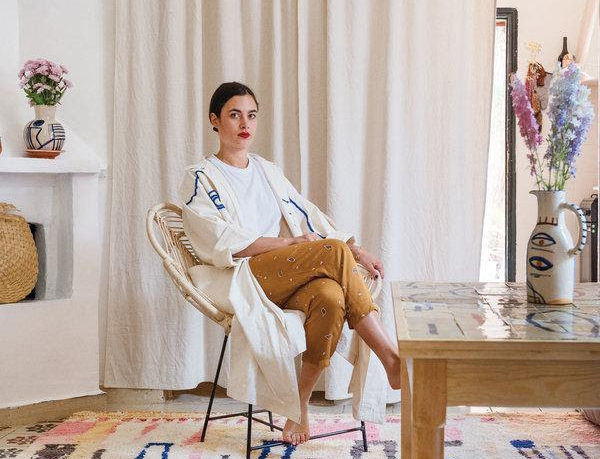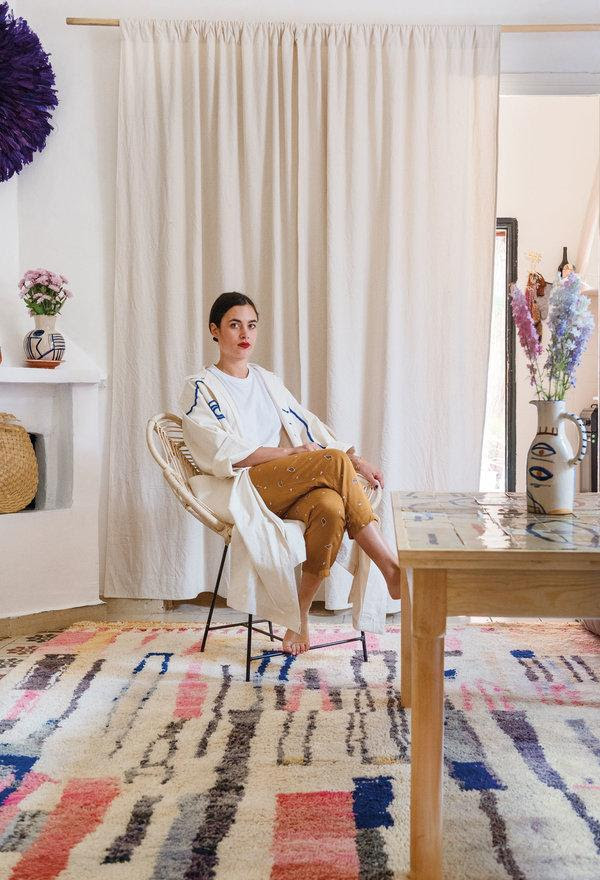New York Times
The Belgian transplant Laurence Leenaert makes her home just like she makes her crafts: by instinct.
Laurence Leenaert in the living room of her Marrakesh home.Alan Keohane.
Most days, the 28-year-old Belgian designer Laurence Leenaert can be found in her sunny studio in Sidi Ghanem, an industrial area of northwest Marrakesh where many of the city’s artisans produce their painted ceramics or leather goods. It is here that Leenaert, with the help of several assistants, creates her own versions of these products for her line, Lrnce, which also includes textiles, mirrors and clothing — all in her distinctive patterns and colors that reference Picasso’s ceramics, Miró’s line drawings and Moroccan tribal patterns.
Her pitchers and vessels — creamy white except for the vibrant shapes, wobbly lines and asymmetrical faces painted onto them — were featured at the Conran Shop during London Craft Week in May and are also found at Le Bon Marché in Paris, Mociun in Brooklyn and at her studio showroom.
Leenaert designed most of the things in the house herself, including the ceramics, desk, chair and paintings in her bedroom.
In the living room, white walls and blond wood are offset by playful accents, including her squiggle-legged stool, embroidered throw pillows and a rug from tribaliste.com.Alan Keohane
Leenaert moved to Morocco on a lark in 2015, with just a sewing machine and 400 euros, after studying at the Royal Academy of Fine Arts in Ghent. In Marrakesh, inspired by the diversity and expertise of local craftsmen, she began sketching rug designs for weavers and cutting patterns for nude leather bags and suede and raffia sandals.
She worked out of the riad she was staying at until it became untenable, her room overflowing with her wares — so many that her Moroccan boyfriend, Ayoub Boualam, was convinced to leave his job in Paris and join the company as its business manager. The pair then found the Sidi Ghanem studio for Lrnce and, closer to the medina in the modern residential borough of Gueliz, another space for themselves — a simple adobe-style house whose shady terrace is lined with olive trees and bougainvillea.
The designer approached the house’s four light-filled rooms in much the same way she does a piece of pottery, starting with a blank slate (in this case white plaster walls) and adding idiosyncratic scribbles and accents — in her usual sophisticated palette of rust, mustard, teal and pink — here and there.
Many of the objects are her own designs (embroidered throw pillows, pots filled with dried wildflowers), and those that aren’t could easily be mistaken for Lrnce: Over the patterned cement tiles of the living room floor lies a large Berber rug purchased from a childhood friend of Boualam’s, as well as a beige wicker chair with a scalloped back. The house doesn’t have a dining room, but the terrace, which is reached through a cheerful galley kitchen, is decorated with shaggy rugs, oversize cushions and a table laid with Leenaert’s vibrant tiles. The couple likes to have watermelon juice and bread with amlou, the local almond spread, here before going to work.
String lights hang over a Leenaert-designed table on the terrace, where the designer starts most days with a fresh juice.Alan Keohane
A painting by Leenaert sits above a shelf in the kitchen.Alan Keohane
Taken as a whole, the space reflects a modern way of thinking that privileges beauty but not preciousness. In the bedrooms, Leenaert’s tapestries are thrown casually over the beds, and her canvases are stacked against the wall. The same is true at the studio. A fast painter, Leenaert isn’t one to obsess over a less-than-perfect line. When she started out, some of her local collaborators were taken aback by her freewheeling approach. “I’m sure they were thinking, Who is this 25-year-old girl messing up my perfect pot?” she says with a laugh. But, over time, they came to understand each other, and Leenaert is proud of those relationships. “A lot of people come to Marrakesh and buy things to sell at a huge markup back in France,” she says. “This is what I absolutely don’t want. I want to start from zero and work with the artisans to make something new.”
Tom Delavan is the design/interiors director of T Magazine.








